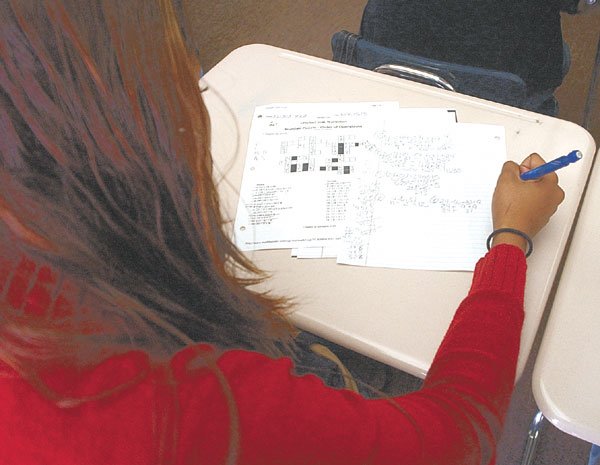Gilroy High School math program revamped in response to low
scores
Gilroy – When Bob Santos walked onto Gilroy High School’s campus 12 years ago, he already had eight years of teaching experience under his belt.
The Gilroy native considered himself to be a skilled and effective math teacher since his students in Stockton did well on assessment tests and in his class.
“I came with this big ego as a teacher,” said Santos, who now chairs the GHS math department.
But at GHS things were different. Parents and community members publicly criticized the math department, pointing to the student’s low California standardized tests as proof of its flaws.
With confidence in his teaching ability because of his experience, the blow to Santos’ ego wasn’t as significant. But other younger, inexperienced educators didn’t handle the heat as well, said Santos, who is GHS’ most senior math teacher.
“We’ve changed all the teachers and the problem is still there,” he said.
Instead of searching for someone to blame, Santos decided to dive in and dig around for solutions. Last year, the math teacher volunteered to chair the math department and began implementing some major changes.
The changes are a reaction to GHS low math scores on the California Standards Test. In general math, on the 2005 CST, only 6 percent of ninth-graders were ranked proficient or advanced. The test is based on sixth and seventh grade standards.
On the algebra I portion, which is taken by freshmen, sophomores and juniors, none of the students were ranked advanced. Four percent of freshman and sophomores were proficient and only 2 percent of juniors.
Travel north to Morgan Hill and students are faring better on the CST math section. At Live Oak High School, 13 percent of the freshman scored proficient on the general math portion.
On the algebra I section, 6 percent of freshman were proficient and 5 percent of sophomores. None of the juniors were proficient. Still, more students ranked basic than GHS.
Students must pass algebra I to earn a high school diploma.
Students are no longer passed onto the next level regardless of their proficiency. Instead, they are bumped up to the next level based on a combination of their grades and scores from the California Standards Test and a national assessment test called Measure of Academic Progress.
In the past, the rule was that GHS students could move up if they had a “C” or better, but that rule was largely ignored, said Cathy Silva, a GHS math teacher and facilitator of the math department remodeling.
Students with “Ds” and even “Fs” were promoted to algebra II without understanding the basics of algebra or geometry. But assessing skills by only looking at grades isn’t effective either, said Silva.
Grades can be skewed and aren’t always a true measure of what a student knows, she said. Still, students can get a waiver and jump to the next level if their test scores weren’t high enough.
Even though they’re still in the program’s infant stage, teachers are much happier because they can teach more effectively to a group of students who are basically on the same level, said Silva.
While her students worked on an assignment, Silva pointed out that the freshmen and sophomores in her Thursday morning pre-algebra class tested at the third grade level in math. Last year, students like Silva’s who have yet to master their addition and multiplication, wouldn’t have had the option to take pre-algebra.
Now the high school offers about eight pre-algebra courses, said Silva.
“The culture of the math department is changing,” she said. “We have … the strongest math department we’ve had in years.”
Math teachers receive a lot more support from one another now. Teachers are collaborating more, visiting one another’s classrooms to observe and meeting to discuss goals and strategies to improve the program, said Silva.
Also, teachers are learning how to make better use of classroom instruction.
Brilliant minds don’t automatically equal great teachers, so math teachers are learning how to best crack open the left side of the brain by implementing a variety of nouveau strategies.
Instead of simply lecturing and then setting the students free to work, teachers are now using more graphics, verbal clues, examples and more student participation.
“We don’t want robots but we need everyone to expect the same proficiency level of students,” said Silva.
The high school has come under fire from some locals who aren’t only concerned about CST scores. The locals blame GHS’ low SAT math scores on the math department. On average seniors score higher on the SAT’s verbal portion.
The high school’s math department revamping isn’t a response to the school’s SAT scores, said GHS Principal Jim Maxwell. The SAT is not an assessment of what students have learned in high school, it’s more of an IQ test, said Maxwell.
The high school’s poor math scores on the CST is an indication that there’s a problem, but GHS shouldn’t take all the blame.
“This has been an issue district-wide,” said Maxwell.
It’s a trickle-up effect. Because the district focused on reading and writing skills, arithmetic suffered, said the principal.
Now that they’ve identified holes, educators and administrators can begin plugging them up.
“And guess what?” said Maxwell. “We focused on English language arts and we improved. Now we’re going to focus on math and we will improve.”














